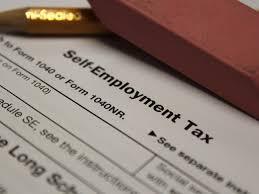
You have to wear many different hats when working alone. Yes, it can be great when you wear the HR hat because you don't have to keep track of vacations. But when you put on your accounting hat, you're stuck tracking your income, expenses, and taxes.
Not only do you have to track more tax information, but you also have to pay more taxes. When you work as an employee for someone else, your employer must pay half of your Social Security taxes (12.4%) (sometimes called FICA) and Medicare (2.9%).
But when you are self-employed, you must pay 15.3% FICA on your own. The IRS calls this the self-employment tax. But when it's time to file your tax, you'll need to file a Schedule SE tax form to pay your self-employment tax.
What is the Schedule SE?
The IRS Schedule SE is a one-page tax form used to calculate self-employment tax. SE stands for, you guessed it, self-employment.
You will need to file Schedule SE when you file taxes at the end of the year. But before you complete Schedule SE, you must complete Schedule C. Another form, right? Seriously, when you're self-employed, there's a huge possibility of getting buried in tax forms.
Schedule C is where you put the money you have earned and deduct your expenses. You can also list self-employment tax deductions such as home office expenses, advertising, vehicle use, office supplies, equipment, software, travel, business, meals, etc.
Who should file Schedule SE?
The IRS requires anyone earning more than $400 in net self-employment income to file Schedule SE. Even the smallest side hustle will quickly send you over the $400 threshold.
The 15.3% self-employment tax is a big part of the change, so you need to track your expenses and income.
And just a quick note: if you plan to pay more than $1,000 in taxes, you'll need to calculate your taxes and make quarterly payments to the IRS.
If tracking payments and tax forms aren't your things, let a tax professional do it for you!
What is self-employment income?
The money you earn from operating your business is considered self-employment income. It is something obvious. But there are several other ways to earn money on your own.
The money you earn driving for Uber/Lyft or mowing the lawn is also considered self-employment income. What about the money you've made from your baking business? Yes, it is taxable. Whether you sell stuff online, work as an independent contractor, or work part-time, it all counts as self-employment income.
Where can I find my self-employment earnings?
I mentioned Schedule C as a place to report self-employment income. Still don't know how much to include in Schedule C?
Well, if you worked as an independent contractor, the company you worked for must submit a Form 1099-NEC showing how much you earned. If you sold items and used a digital payment processor to collect the money, your processor will send you a 1099-K listing of your total sales.
If you run your own business, such as a plumber or hairdresser, you probably won't get 1099. But even if you don't get 1099, it's still your responsibility to track income and report it to the government via Schedule C.
How to complete Schedule SE
Whether you're filling an older paper version or an electronic Schedule SE, it's not too complicated (by IRS standards). Here is a line-by-line breakdown of the Schedule SE form:
Line 1a, 1b: net result of the company. If you make living growing crops or animals, these two lines are where you include income and/or conservation program payments.
Line 2 - Net Income (or Net Loss) on Schedule C. Note this line because Line 2 is where you enter how much you earned as a self-employed.
Line 3: Add lines 1 and 2 together.
Line 4: Multiply the figure you get from line 3 by 92.35%. You owe no self-employment fees if you get less than $400.
Line 5: Church employee income.
Line 6: This is the amount of church employee income subject to tax.
Line 7: Maximum amount subject to social security tax.
Line 8: Add here any regular salaries you already paid Social Security Taxes on.
Line 9: Subtract line 8 from 7. This will show you how much of your self-employment income is taxed to the self-employment tax.
Line 10: Calculate Social Security tax by multiplying the income by 12.4%.
Line 11: Figure out your Medicare tax by multiplying your income by 2.9%.
Line 12: Add lines 10 and 11 together; this is your self-employment tax.
Line 13: Multiply the self-employment tax by 50% and deduct it on Form 1040.
Can I deduct self-employment tax?
Do your eyes light up after reading a line-by-line description of Schedule SE? You may have missed the only positive point of the form: you can deduct half of the self-employment income tax!
You read correctly. The IRS considers the employer's share of FICA a business expense, so you can deduct it from your taxable income when you file 1040. This will save you money on your tax bill.
Hire a professional to manage your taxes
Look, taxes are confusing and even more complicated when you're self-employed. If you feel overwhelmed, a tax expert or CPA can help.
FOR MORE INFORMATION ON HOW TAXES MADE EZ, INC. CAN BEST HELP YOU WITH YOUR TAX FILING NEEDS, PLEASE CLlICK THE BLUE TAB ON THIS PAGE.
THANKS FOR VISITING.
Taxes Made EZ Inc